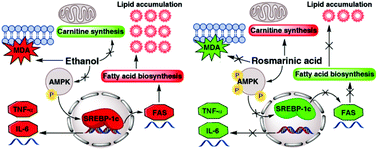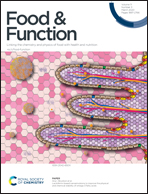Rosmarinic acid alleviates ethanol-induced lipid accumulation by repressing fatty acid biosynthesis†
Abstract
Recent studies have demonstrated that rosmarinic acid is a valuable natural product for treatment of alcoholic liver disease. However, the mechanisms whereby rosmarinic acid improves alcoholic liver disease remain unclear. Here we performed experiments using a non-transformed mouse hepatocyte cell line (AML12). Oil-red O staining demonstrated that rosmarinic acid reduced ethanol-induced lipid accumulation. It was shown that rosmarinic acid prevented ethanol-induced elevation of the malondialdehyde level. We also found that rosmarinic acid inhibited ethanol-induced mRNA expression of tumor necrosis factor-α and interleukin 6. Metabolomics analysis revealed that rosmarinic acid ameliorated ethanol-induced fatty acid biosynthesis in the cytoplasm. In addition, palmitic acid was a candidate biomarker in cells exposed to ethanol or ethanol plus rosmarinic acid. Rosmarinic acid prevented the ethanol-induced increase in sorbitol that is a component of the polyol pathway. Moreover, we confirmed that rosmarinic acid attenuated ethanol-induced mRNA expression of fatty acid synthase, probably by modulating the AMPK/SREBP-1c pathway. Furthermore, rosmarinic acid prevented the ethanol-induced decrease in eight metabolites that are involved in mitochondrial metabolism, including glycine and succinic acid which are the components of carnitine synthesis. These results provide a crucial insight into the molecular mechanism of rosmarinic acid in alleviating ethanol-induced injury.

- This article is part of the themed collection: Food & Function Recent HOT articles


 Please wait while we load your content...
Please wait while we load your content...